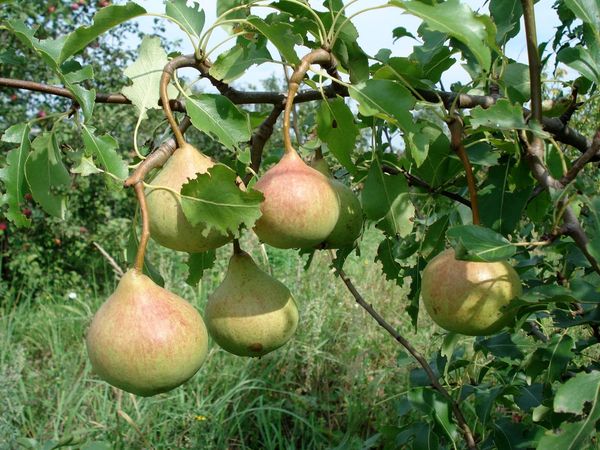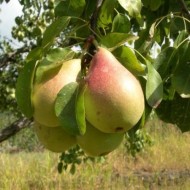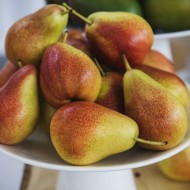We grow a pear Forest beauty in the country: advice for novice gardeners
Content
History and regions of pear growth Forest beauty
The history of the origin of the variety is not entirely common. The tree was discovered by chance, at the beginning of the 19th century, in a Belgian forest, not far from the town of Alost. However, Belgian breeders called the variety differently - Marie-Louise. The unusually sweet taste of the fruit made the pear so popular that by the end of the century it replaced almost all European varieties.

However, today, in modern catalogs, the Forest Beauty is completely separated from the Belgian one. A weighty argument for the division was the lack of complete identity of varietal characteristics, despite their similarity. Another controversial point is the name given to the pear, Lev Simirenko - Butter tree. It does not go through catalogs, but it may well be the author's name.
The North Caucasian and Lower Volga regions of Russia became the regions of zoning of the grade. However, due to its unpretentious care and good tolerance to drought and cold, the variety is grown in other regions of Russia, in particular in the Moscow region.
Video "Rules for planting pears"
In this video, you will learn how to properly plant a pear in the garden.
Description and characteristics of the variety
The external characteristics of the tree practically do not differ from the pear standards that are familiar to us. But varietal characteristics have their own differences.
The appearance of the tree
Depending on the region of growth, the Forest Beauty can be attributed to both medium-sized and tall trees. On average, the height of a pear does not exceed 5 m. In the first decade of its life, the tree actively grows and develops, it is during these years that it reaches its maximum height. Thick straight or slightly arched shoots form a broad-pyramidal medium-leafed crown.
Young shoots are covered with reddish-brown bark, older shoots acquire a grayish color. The leaf plates are medium in size, dark green in color, slightly serrated at the edges. The buds are small, silvery. Small pink-white flowers usually grow in inflorescences up to 10 pieces, but can also be found singly.
Physical and quality characteristics of the fruit
The fruits of the Forest Beauty are medium in size, with a characteristic truncated-ovoid shape, with a small narrow funnel. The average weight of one pear is about 140 g, but in the southern regions and in areas with rich fertile soil, the fruits can reach 300 g.
The skin is rough, dense, but not thick.The color depends on the degree of maturity of the fruit: at an early stage it is greenish-yellow, a ripe pear has a bright blush, which sometimes covers half of the fruit. Small brown spots are observed on the skin, and under it are grayish subcutaneous dots.
The pulp is tender, with an oily consistency, it literally melts in your mouth. The taste of the fruit is very harmonious: not sugary sweetness is ideally combined with a slight sourness. Fruits contain not only sugars and dry substances, but also B vitamins, potassium, calcium, phosphorus, magnesium, fluorine, iron, zinc, iodine, selenium.
The forest beauty belongs to dessert varieties, but despite the rather large amount of sugars, it is considered dietary.
Drought and frost resistance
In some sources, you can find the statement that a pear can withstand frost up to 40°C, but gardeners who grow the variety note that even at 35 ° C frost, the tree can be damaged. Quite resistant to cold and flower buds, which survive recurrent frosts and frosts up to 10 °WITH.
The Beauty is also resistant to heat, tolerates a short drought perfectly. But a long dry period will negatively affect the quantity and quality of the crop.
Pollination, ripening and fruiting dates
The forest beauty is a partially self-fertile variety. Therefore, to increase the yield, it is required to plant a number of suitable pollinators: Lyubimitsa Klappa, Taezhnaya, Michurinskaya, Svetlyanka. It begins to bloom in late April or early May, the first fruits ripen by the end of August. Begins to bear fruit from 3-4 years after planting in a permanent place.
Productivity and application
The average yield of the Forest Beauty is at the level of 130–140 c / ha. In some regions, they may be higher. Also, yield indicators depend on the age of the plant.
Wonderful taste and unobtrusive, but well-expressed aroma make it possible to use fresh pears for making juices and desserts. Both baby puree and caramelized fruit will turn out great. The pear is also perfect for making compotes or drinks from dried pears.
Collection, storage and transportation of fruits
Collect pears at the first sign of ripening. Overripe pears can simply crumble from the branch. The level of transportability is average. Incompletely ripe fruits can be transported over long distances.
Pears can be stored for several weeks at temperatures of 10-15 ° C above freezing in a well-ventilated dry place. At temperatures from 0 to -2 ° C, the storage time can be extended up to a month.
Advantages and disadvantages of the variety
- adaptation to temperature extremes;
- high degree of frost resistance and resistance to return frost;
- generous and regular harvests;
- unpretentiousness to soil and agrotechnical measures;
- resistance to pest attacks;
- good commercial and taste characteristics of the fruit.
- short shelf life of fruits;
- inadmissibility of delay in collecting fruits, otherwise they will crumble and be damaged;
- overripe fruits acquire an unpleasant odor and need to be processed immediately.
The subtleties of growing fruit crops
Growing a Forest Beauty is not difficult at all, you just need to take into account some of the nuances.

General landing rules
The optimal soil for pears will be loose, moist soil. Clay soils will not work - the tree grows and develops poorly. It is better to choose a seedling at least 3 years old, with a healthy developed root system and several shoots. The minimum pit size is 0.8 m (depth and diameter). The distance between seedlings should be at least 3 m.
The main thing is to correctly position the roots: they need to be straightened and arranged in a circle, then sprinkled with fertile soil.
The soil from the pit is mixed with humus, wood ash and a phosphorus-potassium complex. After planting, you need to moisten the soil.
Watering and feeding
The frequency and amount of watering depends on the level of natural precipitation. Usually young trees are watered once a week, for adults one watering per month is enough.
The pear is fed only from 3 years after planting. In the fall, organic matter is applied, and in the spring and summer, complex fertilizers containing potassium and phosphorus.
Crown formation
In order to form the crown, the shoots are cut by approximately ¼. In the spring, in the second year after planting, the central trunk is shortened. Then the lateral branches are formed up to 20 cm. Then the upper tier is laid: the supporting lateral branches (up to 3 buds) are cut, the remaining processes are removed.
Rejuvenating pruning is carried out no more than 1 time in 8-10 years. But sanitary cleaning is needed annually.
Whitewashing and preparation for winter
Although the Forest Beauty is distinguished by excellent frost resistance, it is imperative to prepare the tree for winter. The trunk circle is mulched with peat, humus or sawdust. The trunks of the tree are whitewashed with a solution of lime to a height of about 80 cm. Young trees are wrapped in burlap or paper and covered with a layer of snow.
Disease and pest control methods
The forest beauty has good immunity to various diseases. But it can be affected by scab and powdery mildew. Infection can be prevented by prophylactic treatment with Bordeaux liquid, copper oxychloride or urea.
The pear is resistant to pest attacks. But you should carefully examine the tree for the presence of a pear moth, a tick, a slimy sawfly and a hawthorn. Affected branches should be sprayed with Karbofos or colloidal sulfur.

Gardeners reviews
“I am very pleased with the purchase. Can be grafted onto almost any stock. Bears fruit generously and regularly. You just need to harvest the fruits in time: those that are overripe do not stay for a long time and become tasteless. "
“I am pleased with the unpretentiousness of the care. And the taste of the fruits allows you not only to eat them fresh, but also to prepare delicious preserves. The only thing, as our experienced neighbors advised us, is to treat diseases and pests in time ”.
The advantages of the Forest Beauty are indisputable, but be sure to take into account its shortcomings, so as not to get an unpleasant surprise. Timely preventive maintenance and harvesting will save you from disappointment.



